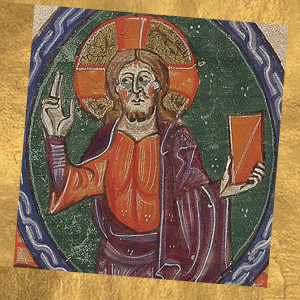St. Eligius, Bishop of Noyon

The generous goldsmith
Born around AD 588, originally from Chaptelat in Limousin, the “Good St. Eligius” belonged to a wealthy rural family who worked their own land, unlike many landowners who left the cultivation to slaves. He left the care of the family farm to one of his brothers, and entered trade as a goldsmith apprentice in a shop in which the royal coin was hammered according to ancient Roman methods. He saved some of the income from his family and gave it in charity to the poor and to slaves. He was as clever in enamel as in gold chiselling. These professional qualities went hand in hand with a scrupulous honesty. When they asked him to make a gold throne for King Clothair II (613-629), he made a second with the extra gold he did not want to hold for himself.
In the service of the king
This gesture, extraordinary at the time, earned him the trust of the king, who asked him to reside in Paris as the Royal Goldsmith, a royal court officer and court counselor. Named coinmaster in Marseilles, he would redeem many of the slaves sold at the port. When Dagobert became king in 629, he was summoned to Paris where he directed the shops of the Frankish kingdom in which coin was minted, which were in Paris on the Quai des Orfèvres at the present-day Rue de la Monnaie. Among others, he had the task of embellishing the tombs of Saint Genevieve and Saint Denis. He made reliquaries for Saint Germain, Saint Severinus, Saint Martin, and Saint Columba, and numerous liturgical objects for the new abbey of Saint Denis. Thanks to his honesty, his frankness, and his capacity for peaceable judgment, he came so far into the king's trust, who often called him to himself, that he entrusted him with a peace mission to the Breton king, King Judicael.
Bishop of Noyon
Great was the piety and prayer life of this layman, who often attended monastic offices. In 632 he founded the Solignac monastery south of Limoges. While Eligius still lived, the monastery had grown to count more than 150 monks under the two rules of St. Benedict and Saint Colomban: the monastery was under the protection of the king and not under the authority of the bishop. The religious fervor and the ardor placed in its work made it one of the most prosperous monasteries of the time. One year after the foundation of Solignac, Eligius founded, in his Ile de la Cité home, the first monastic house for women religious in Paris, whose direction he entrusted to Saint Aurea. A year after the death of Dagobert, whom he had seen in the last moments of his life, Eligius left the court together with Saint Audenus, who had served as counselor and chancellor under Dagobert. Like Audenus, Eligius also enters formation and is ordained priest. On the same day, May 13, 641, they received the episcopate: Saint Audoenus to the See of Rouen; Eligius is made bishop of Noyon and Tournai. Eligius put all his zeal into apostolic mission. He died in 660, on the eve of his departure for Cahors. Holy Queen Bathilde traveled to greet him, but he would come too late.
A Saint Eligius church in Paris
In Paris, a church was dedicated to him in the quarter of the blacksmiths, locksmiths and cabinet-makers: the church of Saint Eligius, rebuilt in 1967. A church destroyed in 1793 was dedicated to him in the Rue des Orfèvres near the Hôtel de la Monnaie (the mint). In Notre Dame cathedral, in the chapel of Saint Ann, once home to the jewelers’ and goldsmiths’ confraternity, the jewelers and goldsmiths of Paris have placed his statue and restored his altar.







